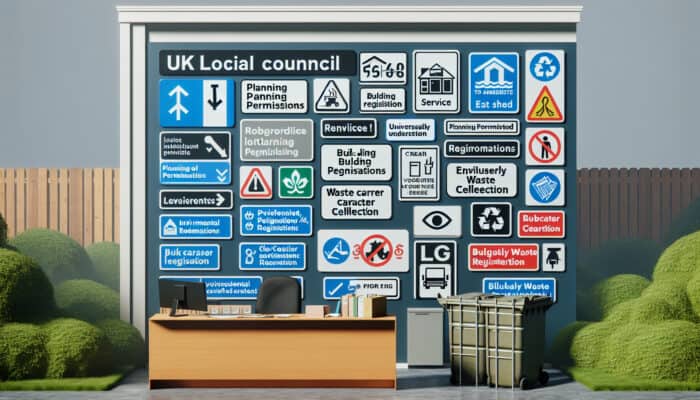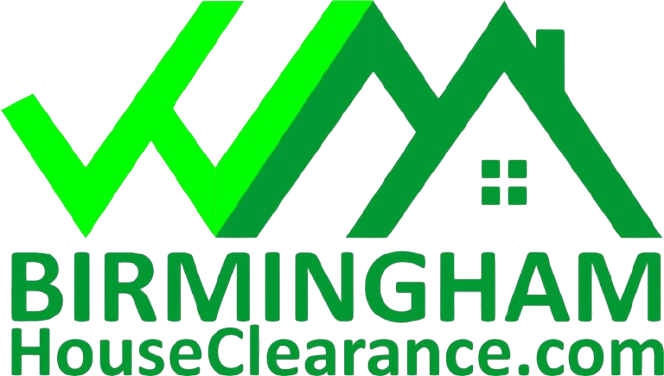Legal Requirements for Clearing a UK Shed
What Permits Are Needed?

Clearing a UK Shed Legally: To clear a shed legally in the UK, it’s essential to understand the various permits that may be required. Each local council in the UK may have different regulations governing the disposal of structures and their contents. Generally, you will need to check with your local authority to determine specific requirements. The following list outlines some of the key permits you may need to consider:
- Planning permission is required for modifying or demolishing a structure.
- Building Regulations Approval for safety compliance.
- Environmental Permits for hazardous waste disposal.
- Waste Carrier Registration is required if hiring a van or a third-party service for disposal.
- Local council permits for bulky waste collection.
- Landfill permits are required if you intend to dispose of waste at a landfill site.
Understanding these permits is crucial to avoid legal repercussions. Engaging with your local council can provide clarity on what’s specifically required for your area. Additionally, consulting a legal expert familiar with property regulations can ensure comprehensive compliance throughout the shed-clearing process.
Waste Disposal Regulations
Navigating the UK’s waste-disposal regulations during a shed-clearing operation is vital for both environmental and legal compliance. The Environmental Protection Act 1990 establishes a framework governing waste management. If your shed contains general waste, you must dispose of it through approved methods that comply with local waste management policies. This includes understanding how to handle potentially hazardous materials, such as paints, solvents, and electrical items, which require special attention.
For hazardous materials, certain guidelines must be adhered to, such as:
– Identifying items that fall under hazardous waste categories.
– Ensuring safe storage and transportation of hazardous items to licensed disposal facilities.
– Notifying your local council if large quantities of hazardous waste are involved.
– Keeping records of disposal activities for transparency and compliance.
Recycling obligations are also in place, encouraging homeowners to sort recyclable materials, including metal, wood, and plastic. By adhering to these regulations, you not only protect the environment but also mitigate the risk of fines and legal consequences.
Documentation and Record Keeping
Proper documentation and record-keeping are crucial when clearing a shed. Maintaining clear records not only helps in compliance with UK legal standards but also protects homeowners in the event of disputes or inspections. Essential documents may include:
- Receipts for all waste disposal services used.
- Records of any hazardous materials handled.
- Correspondence with local councils regarding permits.
- Photographic evidence of the shed before and after clearing.
- Risk assessments are conducted throughout the process.
- Inventory of items disposed of or recycled.
These documents serve as proof of compliance and provide a clear record of actions taken during the shed-clearing process. If you face queries from local authorities or neighbours, maintaining a well-maintained record can demonstrate diligence and compliance with legal requirements.
Health and Safety Compliance

Adhering to health and safety regulations is paramount during any shed clearing operation in the UK. The Health and Safety at Work Act 1974 outlines the necessity for risk assessments and safety protocols. When planning your shed clearance, ensure you conduct a thorough risk assessment to identify potential hazards, such as sharp tools, heavy lifting, or exposure to hazardous materials.
Utilising appropriate protective equipment (PPE) is crucial for safety compliance. Essential PPE may include hard hats, gloves, goggles, and steel-toe boots. Workers involved in the process should be adequately trained in using this equipment to prevent injuries. Additionally, creating a safe working environment involves:
- Ensure adequate ventilation, especially if working indoors.
- Having first aid supplies readily available.
- Establishing clear lines of communication among team members.
- Setting up safe pathways to avoid tripping hazards.
Ignoring safety protocols not only increases the risk of accidents but can also lead to legal consequences if an injury occurs during the process. Hence, prioritising health and safety in the shed clearing operation promotes not only compliance but also the well-being of all individuals involved.
Expert Insights on Clearing a UK Shed Legally
What Are the Best Practices?
Clearing a shed legally requires implementing best practices to ensure efficiency and compliance. Expert recommendations suggest starting with a comprehensive plan that incorporates all necessary legal considerations. One effective method is the gradual decluttering approach, where you systematically sort through items, categorising them into keep, recycle, or dispose of. This method not only simplifies the process but also helps make informed decisions about what to do with each item.
Engaging a professional service can offer significant advantages, particularly for homeowners unfamiliar with local regulations. Professionals often possess extensive knowledge of waste disposal laws and can facilitate the required documentation. For example, a case study from a property management firm in London showed that by hiring experts, residents saved an average of 25% in disposal costs compared to handling it independently.
Another critical best practice involves establishing a timeline for the clearance. Setting deadlines for each phase of the project can help maintain momentum and accountability. It’s advisable to contact local councils to check for any potential restrictions or requirements specific to your location, ensuring you remain compliant throughout the process.
How to Handle Unexpected Findings?
During the shed-clearing process, you may encounter unexpected items, including old tools and potentially hazardous materials. How you handle these discoveries is vital for legal compliance and safety. In such cases, the first step is to assess the item and determine its nature. For example, if you come across old paint tins, you must identify whether the contents are hazardous.
If hazardous materials are found, it’s crucial to follow proper disposal procedures, which may involve contacting professional waste disposal services trained to handle them. It’s also prudent to document the finding, take photographs, and maintain detailed records to demonstrate compliance with waste-disposal regulations.
In the event of discovering items of significant value or interest, such as antiques or collectables, consider consulting an expert in that specific field. This could provide a legal avenue for ownership or sale, helping offset some of the costs incurred during shed clearance. Engaging with experts not only ensures compliance but can also yield financial benefits.
What Tools Are Recommended by Experts?
When it comes to clearing a shed legally and efficiently, utilising the right tools is essential. Experts recommend a range of tools that facilitate safe and effective clearing while complying with UK regulations. Here’s a list of essential tools that can help you throughout the process:
- Heavy-duty gloves for hand protection.
- Dust masks to prevent inhalation of harmful particles.
- A sturdy ladder for safely accessing high areas.
- All-purpose cleaning supplies for tidying up after removal.
- A strong refuse bag for general waste disposal.
- Labelling materials to categorise items for keeping or disposal.
- Basic hand tools such as hammers, screwdrivers, and wrenches for dismantling.
- A wheelbarrow or trolley for transporting heavier items.
Equipping yourself with these tools not only enhances safety but also contributes to a more organised and efficient clearing process. Having the right equipment at hand can significantly reduce the time spent on clearing the shed and ensure compliance with health and safety standards.
Safety Measures When Clearing a UK Shed
Personal Protective Equipment
Utilising personal protective equipment (PPE) during the shed-clearing process is essential to ensure safety and compliance with UK regulations. PPE serves as the first line of defence against potential hazards, such as sharp objects, toxic materials, or dust particles. The importance of PPE cannot be underestimated, as it significantly reduces the risk of injuries and illnesses that can occur during such activities.
Recommended PPE includes durable gloves to protect hands from cuts and scrapes, safety goggles to shield eyes from flying debris, and a dust mask to prevent respiratory issues from inhaling harmful particles. For tasks involving heavy lifting or potential impacts, steel-toe boots and hard hats are advisable. These protective measures not only keep individuals safe but also comply with the regulations under the Health and Safety at Work Act.
In addition to individual protection, it’s crucial to ensure that the workspace is well-organised and free of hazards. Clear pathways, proper tool storage, and adequate ventilation can further enhance safety during the shed-clearing process. Failing to utilise PPE and maintain a safe environment can lead to serious accidents, resulting in legal repercussions and financial liability.
What Are the Risks of Ignoring Safety?
Ignoring safety protocols during the shed clearing process poses significant risks not only to the individual involved but also to others around them. The potential hazards include physical injuries, such as cuts, sprains, and fractures, arising from mishandling tools or improper lifting of heavy items. Additionally, exposure to hazardous materials can result in long-term health complications, leading to costly medical treatment and legal issues.
Common risks associated with neglecting safety measures include:
- Injuries from falling objects or improper lifting techniques.
- Exposure to hazardous waste can lead to respiratory problems or skin irritations.
- Accidents caused by slipping or tripping on cluttered surfaces.
- Legal liabilities arising from failing to comply with health and safety regulations.
The repercussions of these risks can be severe, both physically and financially. Homeowners may face legal action from neighbours or local authorities if accidents occur due to negligence. Hence, adhering to safety protocols is not only a legal requirement but also a moral responsibility to protect oneself and others during shed clearance.
Emergency Procedures
In any project involving physical labour, having a clear plan for emergency procedures is essential. During shed clearing, accidents may occur; knowing how to respond promptly can mitigate injuries and legal consequences. The first step is to ensure that all personnel involved are briefed on emergency protocols before commencing the clearance.
Establish a clear chain of command and designate an individual responsible for handling emergencies. This person should have access to first aid supplies and know how to contact emergency services if necessary. In the event of an injury, it’s crucial to assess the situation calmly. If the injury is severe, do not attempt to move the injured person; instead, call for professional medical assistance immediately.
Additionally, keeping a first aid kit readily accessible is vital. This kit should include items such as bandages, antiseptic wipes, and pain relief medication. Regular training on first aid techniques can equip individuals with the necessary skills to handle emergencies effectively. Having a structured emergency plan not only ensures compliance with health and safety laws but also fosters a culture of safety among all participants in the shed clearing process.
How to Dispose of Different Types of Shed Contents?
Hazardous Materials
Proper disposal of hazardous materials found in a UK shed is crucial for compliance with environmental laws and for safeguarding health and safety. Items such as old paint, solvents, chemicals, or batteries can pose significant risks if not handled correctly. The first step is to determine whether any materials in the shed are hazardous by referring to the Hazardous Waste Regulations.
Once identified, hazardous materials must be stored safely in clearly labelled containers until they can be disposed of properly. Many local councils offer special collection services for hazardous waste, so contacting your local authority is a wise move to understand their specific procedures. Additionally, you may be required to complete a hazardous waste consignment note to document the disposal.
Another option is to engage licensed hazardous waste disposal companies, which can ensure that materials are disposed of in compliance with UK regulations. Doing so not only protects the environment but also mitigates the risk of legal repercussions from improper disposal of hazardous materials. By following these steps, you contribute to a safer community and promote responsible waste management.
Recyclable Items
When clearing a shed, many items can be recycled instead of disposed of as general waste. Embracing recycling not only supports environmental sustainability but may also reduce disposal costs. Common recyclable materials found in sheds include metal, wood, plastics, and cardboard. The first step is to sort these materials into designated recycling piles.
Local councils often have recycling facilities or designated collection days for recyclable items. Familiarising yourself with these services can make the recycling process more straightforward. Ensure that items are clean and free of contaminants, as this will promote effective recycling and minimise contamination in recycling streams.
Additionally, certain charitable organisations may accept donations of usable items such as tools, garden equipment, or furniture, extending the lifespan of these goods. This not only reduces landfill waste but also benefits others in the community. By prioritising recycling and donation, individuals can significantly reduce their environmental impact while legally and responsibly clearing a shed.
What to Do with Large Items?
Disposing of large items from a shed, such as old furniture or bulky tools, requires careful planning and adherence to legal guidelines. The first consideration is whether the item can be reused or donated. Many local charities and community projects accept donations of large items in good condition, providing a sustainable alternative to disposal.
If disposal is necessary, check with your local council regarding their policies on bulky waste collection. Many councils offer scheduled collection services for oversized items, ensuring that they are disposed of responsibly. There may be a small fee for this service, but it often includes proper handling and recycling wherever possible.
When large items are too heavy to move independently, hiring a professional waste removal service may be the best option. These experts are equipped to handle bulky items safely and legally. Additionally, using a licensed waste carrier ensures that the disposal complies with UK regulations, protecting you from potential legal repercussions associated with improper disposal.
Environmental Considerations in UK Shed Clearing
What Are the Ecological Impacts?
The ecological impacts of clearing a shed can be significant if not managed responsibly. The disposal of waste materials, especially hazardous ones, can lead to soil contamination and harm local ecosystems. Understanding the potential environmental consequences is crucial for responsible shed clearing. For instance, improper disposal of paints or chemicals can leach into groundwater, posing a risk to wildlife and public health.
Mitigating these impacts involves adhering to local environmental regulations and employing best practices for waste management. This includes recycling materials whenever possible, using environmentally friendly disposal methods, and opting for certified waste disposal services that comply with the UK’s stringent environmental policies. By adopting sustainable practices, you help preserve local ecosystems while ensuring your shed-clearing operation aligns with environmental standards.
Additionally, raising awareness of the ecological impacts among neighbours and community members fosters a culture of environmental responsibility. By sharing knowledge and encouraging sustainable practices, you promote a collective effort to safeguard the environment during shed-clearing activities.
Sustainable Practices
Adopting sustainable practices during the shed clearing process aligns with the UK’s commitment to environmental conservation. One of the foremost sustainable practices is to minimise waste generated during the clearing operation. This can be achieved by implementing a ‘reduce, reuse, recycle’ approach. Prioritising the reuse of items, such as repurposing old tools or materials for new projects, significantly lowers the amount of waste sent to landfills.
Engaging with local recycling initiatives can also be beneficial. Many councils run programmes that promote recycling and offer facilities for specific materials. By participating in these initiatives, homeowners can ensure that their waste is disposed of sustainably. Furthermore, seeking out environmentally friendly products and materials during any subsequent rebuilding or organising efforts in the shed fosters a more sustainable approach.
Educating yourself and your community about eco-friendly practices can lead to more sustainable behaviours in future shed clearings. Sharing information on sustainable disposal options, recycling facilities, and the importance of responsible waste management can encourage others to adopt similar practices, creating a community-wide impact on environmental conservation.
Wildlife Protection Laws
When clearing a shed, it’s essential to comply with wildlife protection laws that protect local fauna and flora. The Wildlife and Countryside Act 1981 safeguards certain species and habitats in the UK, making it illegal to disturb or harm protected wildlife. Before commencing the clearance, assess the area for signs of nesting birds, bats, or other wildlife that may be residing in or around the shed.
If you suspect that wildlife may be present, it’s advisable to consult with local wildlife experts or organisations. They can provide guidance on how to proceed without infringing on wildlife protection laws. In some cases, postponing the clearing until after breeding seasons may be necessary to ensure compliance.
Additionally, when disposing of organic materials such as garden waste, ensure they do not contribute to habitat destruction. Responsible disposal involves either composting or taking organic waste to designated facilities. By adhering to wildlife protection laws, you not only fulfil your legal obligations but also contribute to preserving the biodiversity of your local area.
Waste Management and Recycling
Effective waste management and recycling are crucial components of a legal and environmentally responsible shed clearing operation. Understanding the local waste management system is the first step towards ensuring compliance. Local councils typically provide guidelines on what materials can be recycled, where to dispose of bulk waste, and the processes for hazardous materials.
When clearing a shed, segregate waste into recyclable and non-recyclable categories. This helps streamline the disposal process and ensures that recyclable materials are not inadvertently sent to landfills. Many councils offer recycling facilities, and it’s worth researching their specific requirements for various materials, such as metal, wood, and plastics.
Moreover, using professional waste disposal services can simplify the process by ensuring that all waste is managed in accordance with UK regulations. These services often include sorting and transporting materials to appropriate recycling centres. By adopting effective waste management practices, homeowners help reduce landfill waste and promote a sustainable approach to clearing a shed.
Research-Backed Benefits of Clearing a UK Shed Legally
Improved Property Value
Legally clearing a shed can significantly enhance the property value in the UK. A clutter-free, well-maintained outdoor space not only enhances aesthetic appeal but also increases functionality, making the property more attractive to potential buyers. Research indicates that homes with well-organised outdoor spaces command higher prices, as buyers appreciate the added usability and visual appeal.
Homeowners can take actionable steps to maximise property value by ensuring compliance with local regulations through legal clearance. Engaging with professionals in the field can provide insights on how to present the cleared space effectively, including landscaping or adding storage solutions that appeal to buyers. Furthermore, maintaining records of the clearing process can demonstrate diligence and care, further enhancing the property’s marketability.
Additionally, fostering a positive perception among neighbours through well-executed shed clearance can improve relationships and may also influence property value. By legally undertaking the clearing process, homeowners not only enhance their property but also elevate the overall desirability of the surrounding area.
What Are the Legal Advantages?
Adhering to UK regulations during shed clearing offers numerous legal advantages that protect homeowners from potential repercussions. By following proper procedures, individuals significantly reduce the risk of fines, legal actions, or disputes with local authorities. Understanding and complying with waste disposal regulations ensures that all materials are handled lawfully, mitigating liability risks associated with illegal dumping or improper disposal.
Additionally, documenting all aspects of the clearing process establishes a clear record of compliance. This documentation can be invaluable in defending against potential negligence or environmental violation claims. Furthermore, engaging with local councils or regulatory bodies fosters a cooperative relationship that can make navigating future projects or renovations easier.
By prioritising legal compliance during shed clearance, homeowners not only safeguard their interests but also contribute to a culture of accountability and responsibility within their communities. This proactive approach enhances trust and reliability, fostering better relations with neighbours and local authorities.
Community and Neighbour Relations
Clearing a shed legally not only benefits the homeowner but also positively impacts community and neighbour relations. An organised, well-maintained outdoor space contributes to the neighbourhood’s overall appeal, fostering pride among residents. Conversely, neglected or cluttered properties can lead to disputes, complaints, or a decline in community standards.
By engaging in a legal and responsibility-clearing process, homeowners demonstrate a commitment to their property and the surrounding area. This proactive stance can facilitate positive interactions with neighbours, leading to improved relationships and a sense of community. Additionally, sharing information about the clearing process or inviting neighbours to participate can create a sense of camaraderie, further enhancing community bonds.
Moreover, a clean and organised environment reduces potential hazards to neighbours, such as pests, fire risks, and unpleasant odours. By prioritising legal clearance, homeowners contribute to a safer and more pleasant living environment for all. Ultimately, fostering positive community relations through responsible property management creates a more harmonious neighbourhood atmosphere.
What Are the Costs Involved in Clearing a UK Shed?
Professional Services
Hiring professionals for shed clearing can incur various costs, but it often results in a more efficient and legally compliant process. The expenses associated with professional services can vary based on several factors, such as the size of the shed, the quantity of items to be cleared, and the specific services provided. On average, homeowners can expect to pay between £200 and £600 for professional shed clearance in the UK, depending on the job’s complexity.
Professional services typically cover a range of activities, including the removal of items, sorting, waste disposal, and environmental compliance. Engaging experts ensures that all aspects of the process are handled legally, reducing the risk of fines or legal issues stemming from improper disposal. Additionally, professionals often provide valuable insights on how to maximise efficiency and minimise waste, potentially lowering overall costs in the long run.
When considering professional services, obtaining multiple quotes can help homeowners gauge a fair price. It’s also wise to inquire about included services and any additional fees that may arise during the clearance process. By investing in professional assistance, homeowners can streamline the clearance, ensuring compliance while saving time and effort.
Disposal Fees
Understanding the disposal fees associated with clearing a shed is essential for budgeting and financial planning. Disposal fees can vary significantly based on the type and quantity of waste generated during the clearing process. Common factors that influence disposal fees include the weight of the waste, the type of materials being disposed of, and the local council’s regulations.
For instance, local councils may charge fees for bulky waste collection, with costs typically ranging from £15 to £50 for larger items. Hazardous waste disposal may incur higher fees due to the specialised handling required, often ranging from £50 to £150, depending on the materials involved. It’s crucial to check with your local authority for specific fee schedules and available waste-disposal options.
Homeowners can also save costs by utilising recycling centres, which often accept certain materials free of charge. Additionally, engaging professional waste disposal services can provide a clearer understanding of the total costs, as these companies typically include disposal fees in their quotes. By budgeting for disposal fees and exploring available options, homeowners can manage costs effectively while ensuring compliance with waste management regulations.
What Are the Potential Savings?
While clearing a shed can incur costs, homeowners can employ several strategies to save money while ensuring compliance with UK laws. One of the most effective ways to save is by recycling as much waste as possible. Many local councils offer free recycling services, allowing homeowners to dispose of certain materials without incurring fees.
Engaging in a DIY approach to shed clearing can also lead to significant savings. By tackling the project independently, homeowners can avoid labour costs associated with hiring professionals. However, it’s essential to balance this with the potential risks of improper disposal or safety hazards, making it vital to remain informed about legal requirements.
Furthermore, selling or donating reusable items can help offset some of the costs of clearing the shed. Online marketplaces or local charity shops provide avenues for passing on unwanted items, promoting sustainability while potentially generating income. By combining these strategies, homeowners can effectively manage costs and ensure the shed-clearing process remains both legal and financially prudent.
Timeline and Planning for Clearing a UK Shed
How Long Does the Process Take?
The duration of the shed-clearing process can vary based on several factors, including the shed’s size, the volume of items to be cleared, and the homeowner’s level of preparation. Typically, homeowners can expect the process to take anywhere from a few hours to several days. For smaller sheds with minimal contents, a single day may suffice for a thorough clearing, whereas larger sheds with extensive clutter may require a longer timeline.
Several factors can affect the duration of the clearing process. These include:
– The complexity of sorting items into keep, recycle, or dispose categories.
– The need for additional time to engage with local councils for permits or collection services.
– Weather conditions for the clearing process conducted outdoors.
– The availability of necessary tools and PPE for the project.
Effective planning can help streamline the process and ensure that it remains within the anticipated timeline. By creating a comprehensive plan that includes a schedule and clearly defined tasks, homeowners can maintain momentum and efficiently clear the shed.
Creating a Clearing Plan
Developing a comprehensive plan for clearing a shed is essential to ensure all legal and safety aspects are covered. A well-structured plan outlines each phase of the process, allowing for efficient execution. Begin by assessing the shed’s contents and identifying specific tasks, such as sorting items, identifying hazardous materials, and arranging disposal.
Establishing a timeline is equally important. Allocate time slots for each task, accounting for breaks and unexpected delays. It’s also wise to gather all necessary tools and supplies beforehand to avoid wasting time during the clearing process. Additionally, engaging family members or friends can help distribute tasks and make the process more manageable.
Finally, be sure to account for legal requirements, such as obtaining any necessary permits and understanding local waste-disposal regulations. By following these steps and maintaining a clear focus on the plan, homeowners can efficiently navigate the shed-clearing process while ensuring compliance with UK laws.
Post-Clearing Responsibilities
After successfully clearing a shed, homeowners must understand their legal responsibilities regarding site restoration and documentation. Once the cleaning is complete, it’s essential to review the area for any remaining debris or hazardous materials. Ensuring that the site is clean and safe contributes to overall community health and safety.
Maintaining documentation from the clearing process is equally important. This includes keeping records of all waste disposal activities, any hazardous materials handled, and correspondence with local councils regarding permits. These documents serve as proof of compliance and can be crucial if questions arise in the future.
Additionally, consider the potential for future use of the cleared space. Planning for landscaping, storage solutions, or even further renovations can enhance the property’s usability and value. By fulfilling post-clearing responsibilities, homeowners not only comply with legal obligations but also contribute to the overall aesthetic and functionality of their property.
Legal Considerations and Permits
Understanding the legal permits and considerations required to clear a shed in the UK is critical to ensure compliance with local regulations. Before commencing the clearing process, homeowners should contact their local council to ascertain specific requirements that may apply. This may include permits for structural modifications or waste-disposal regulations that must be adhered to.
Always stay informed about any changes to local laws or policies on waste management, as these regulations can frequently evolve. Additionally, maintaining a clear record of all communications and obtained permits can provide protection and validation should any issues arise in the future.
By prioritising legal considerations and ensuring compliance with permits, homeowners can navigate the shed-clearing process with confidence. This approach not only avoids potential legal repercussions but also fosters a sense of trust and accountability within the community.
FAQs
What permits do I need to clear a shed in the UK?
You may require planning permission, building regulations approval, and waste disposal permits, depending on your local council’s regulations and the nature of the materials involved.
How can I dispose of hazardous materials from my shed?
Hazardous materials must be identified, stored safely, and disposed of through licensed waste disposal services or local council hazardous waste collection programmes.
What are the common safety measures for clearing a shed?
Utilising personal protective equipment (PPE), such as gloves, goggles, and masks, alongside conducting risk assessments, is a vital safety measure during shed clearing.
Can I recycle items found in my shed?
Yes, many items can be recycled. Check with your local council for recycling facilities and guidelines for specific materials, such as metal, wood, and plastics.
What should I do if I find unexpected items during clearing?
Assess the items to determine their nature. For hazardous materials, follow proper disposal methods and consult experts if valuable items are found.
How long does it usually take to clear a shed?
The time required to clear a shed can vary widely, depending on its size and contents, typically ranging from a few hours to several days.
What tools do I need for clearing a shed?
Essential tools include heavy-duty gloves, dust masks, a sturdy ladder, refuse bags, and basic hand tools for dismantling items.
What are the costs involved in professional shed clearing?
Costs vary based on the job’s complexity, typically ranging from £200 to £600, depending on the shed’s size and the services required.
How does clearing a shed legally affect property value?
A clean and well-maintained outdoor space enhances property value, making it more attractive to potential buyers and boosting overall marketability.
What are the responsibilities after clearing a shed?
Post-clearing responsibilities include site restoration, maintaining documentation of the clearance, and planning for future use of the cleared space.






